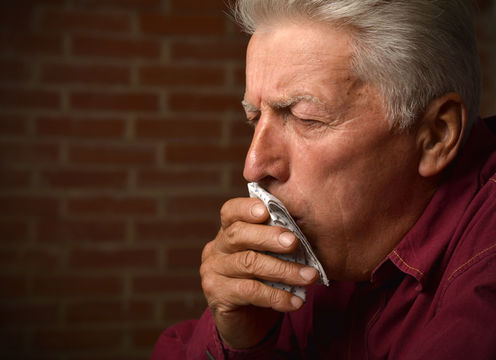
Chronic lower respiratory diseases are a group of conditions affecting the lungs. The group is the fourth leading cause of death in Australia.
The three main contributors to the death rate from chronic respiratory diseases are: chronic obstructive pulmonary disease (COPD), asthma and bronchiectasis or permanent damage to the airways.
Lung basics
The lung is like an upside-down tree where the wind pipe (trachea) is the trunk and the bronchi are the branches that get smaller as they branch out deep into the lung. Chronic lower respiratory diseases affect the branches.

Damage to these from toxins, chronic infection or inflammation affects the function of the whole lung. Millions of tiny air sacs (alveoli) are like the leaves surrounded by a network of tiny blood vessels (capillaries). These transport oxygen from the lung to the body via the circulatory system.
If air can’t reach the alveolar air sacs, oxygen can’t be absorbed, body tissues can’t be fuelled and waste gases can’t be expelled efficiently. As compensation, the brain sends signals to increase our breathing, which we experience as feeling short of breath.
Chronic obstructive pulmonary disease (COPD)
Chronic obstructive pulmonary disease (COPD) is responsible for the majority of deaths from chronic lower respiratory diseases. In 2014, nearly 7,000 deaths were attributable to COPD and emphysema combined, compared to 411 from asthma. Around 7.5% of people over 40 are estimated to have COPD in Australia.
Although factors like pollution can influence the development of COPD, in Australia, cigarette smoke is the largest contributor and it is often thought of as smoker’s lung disease.
COPD is characterised by irreversible narrowing of the bronchi. Chronic inflammation scars and thickens the bronchial walls, obstructing the air flow in and out of the lung. Emphysema is technically a description of the destruction of the alveolar sacs, while COPD is the name given to the disease as a whole, which includes both the bronchial narrowing and the emphysema.
The majority of people with COPD will actually die from heart disease – which is the biggest killer in Australia as a whole and is particularly common in people with COPD. COPD as cause of death is also likely to be under-reported.

Even with the under-reporting, the rate of death from COPD is increasing, as opposed to the rate of death from heart disease, which has decreased over the last few decades. In 2014, COPD accounted for 4.5% of all deaths, compared to 3.7% in 2005.
This is mainly due to COPD being associated with ageing, so it’s expected death rates will increase as our population ages. But the main preventable risk factor for COPD is cigarette smoking. And while levels in Australia are at a record low, there is a long lag effect, which means we are still seeing results of past high smoking rates coming through.
Lastly, we still have no effective treatments that decrease death from COPD, just those that help with symptoms. The only intervention shown conclusively to reduce death from COPD is quitting smoking. Thankfully, this intervention also reduces the risk of death from other diseases such as heart disease and stroke – which will help people with COPD live longer.
Compared to COPD, the death rate due to asthma is very low. Asthma is also a disease of the bronchi characterised by acute episodes or “attacks” of bronchial narrowing and obstruction of air flow.
About 10% of Australians, or around 2.3 million people, suffer from asthma. Long-standing asthma – which usually begins in childhood – can lead to permanent or irreversible narrowing of the bronchi, particularly if inadequately treated. It may then begin to resemble COPD.

While the rate of asthma cases has increased over the last few decades, the rate of death from asthma has decreased. Preventer puffers containing steroid medication are the main line of treatment for chronic asthma. They decrease inflammation inside the asthmatic lung and have been shown to prevent death from asthma, as well as improve symptoms and maintain normal lung function.
Death from asthma in Australia now accounts for less than 0.3% of all deaths, or only 1.5 deaths per 100,000 people in 2014. This represents a success story in the management of chronic lower respiratory diseases.
Bronchiectasis
Bronchiectasis (from the Greek ektasis, or stretching) is different to bronchitis, which is just inflammation of the bronchi commonly caused by viruses. Brochiectasis occurs when damage to supporting tissue structures of the bronchi make the walls go floppy and enlarge, instead of maintaining their small tubular structure. Dilated bronchi operate inefficiently as mucus collects inside them rather than being expelled, creating an ideal environment for infections.
The disease is characterised by chronic moist cough with phlegm, recurrent infections and breathlessness. Death is often due to complications of the disease, such as infection or major bleeding from the lungs.
In the general Australian community, bronchiectasis accounts for only 0.2% of all deaths, or 1.3 deaths per 100,000 people. In the Aboriginal and Torres Strait Islander population, the death rate is around six times that of non-indigenous Australians.
Early respiratory infection in Aboriginal and Torres Strait Islanders probably explains its higher prevalence there; partly as a result of bacterial accumulation in the nasal passage from living in close quarters, general social disadvantage and poor access to health care.
Can we drive down the death rate?
Finding effective treatments is essential if we want to decrease the death rate from COPD. Until then, prevention – mainly by reducing smoking rates – remains the only hope.
Continuing our success in driving down the asthma death rate relies on encouraging people with asthma to take their prescribed treatments, which are proven to be effective at reducing death, and by addressing the disease’s underlying causes.
Finally, addressing the disparity in death due to bronchiectasis between our Indigenous and non-Indigenous communities by improving living standards and access to health care must be a high priority.
Stephen Milne receives funding from the National Health and Medical Research Council
